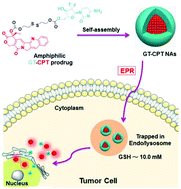Gemcitabine–camptothecin conjugates: a hybrid prodrug for controlled drug release and synergistic therapeutics†
Abstract
Drug self-delivery systems represent an important approach to enhance the therapeutic efficacy for cancer therapy. We report the design, synthesis and characterization of a new amphiphilic small molecule prodrug based on two types of anticancer drugs, the hydrophilic gemcitabine and hydrophobic camptothecin, linked by a disulfide bond and abbreviated as GT–CPT. The obtained amphiphilic prodrug conjugates self-assembled into nanoparticles in water and showed strong micellar stability and excellent blood compatibility in vivo. The GT–CPT prodrug conjugates could realize precise drug loading as high as ∼75 wt% demonstrating a carrier-free model for efficient drug delivery. Furthermore, the reduction-responsive disulfide bond enabled controlled drug release in the presence of tumour-specific microenvironment. It was found that each of these hybrid drug components (CPT and GT) not only showed enhanced cytotoxicity individually but also exhibited a prominent synergistic effect on HeLa and MCF-7 cancer cells. This study demonstrated the promising potential of this stimuli-responsive hybrid prodrug conjugate for highly efficient co-delivery of multiple anticancer chemotherapeutics, which could inspire further applications using such hybrid prodrug conjugates for combination cancer chemotherapy.



 Please wait while we load your content...
Please wait while we load your content...